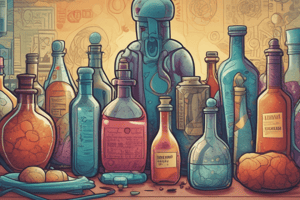Podcast
Questions and Answers
What is the primary use of Sodium Carbonate?
What is the primary use of Sodium Carbonate?
- Antacid
- Saponifying agent (correct)
- Expectorant
- Oral rehydrating salt
What is the antidote for hypermagnesemia (magnesium toxicity)?
What is the antidote for hypermagnesemia (magnesium toxicity)?
Calcium gluconate
What is the component of the universal antidote that involves magnesium oxide?
What is the component of the universal antidote that involves magnesium oxide?
- Epsom salt
- Tannic acid
- Magnesium oxide (correct)
- Activated charcoal
What is the antidote used in barium and barbiturate toxicity?
What is the antidote used in barium and barbiturate toxicity?
What is the antidote for Cyanide Poisoning that involves Sodium Nitrite?
What is the antidote for Cyanide Poisoning that involves Sodium Nitrite?
Aluminum is the most abundant of all metals.
Aluminum is the most abundant of all metals.
Ammoniated Silver Nitrate is an effective treatment for vaginitis. (True/False)
Ammoniated Silver Nitrate is an effective treatment for vaginitis. (True/False)
Copper Sulfate is an antidote for phosphorous poisoning along with ____ and ____. (Separate answers with a comma)
Copper Sulfate is an antidote for phosphorous poisoning along with ____ and ____. (Separate answers with a comma)
Natural sources of calcium include Dolomite, Fluorite, Gypsum, and ___________.
Natural sources of calcium include Dolomite, Fluorite, Gypsum, and ___________.
Match the following terms with their descriptions:
Match the following terms with their descriptions:
Flashcards are hidden until you start studying
Study Notes
Sodium
- Diuretic, antacid, and alkalizing agent
- Sodium acetate: diuretic, and alkalizing agent in Benedict's solution
- Sodium bicarbonate: antacid, antioxidant, and baking soda
- Sodium bisulfate: antigas and antacid
- Sodium chloride: condiment, oral rehydrating salt, and “table salt” or “rock salt”
- Sodium biphosphate: urinary acidifier for cystitis
- Sodium carbonate: antacid, and “anhydrous” – soda ash, “dihydrate” – trona, and “decahydrate” – sal soda, washing soda, soda crystals
- Sodium fluoride: anticariogenic agent (2%)
- Sodium hydroxide: saponifying agent (soap making), and “caustic soda” or “sosa” or “lye”
- Sodium hypochlorite: disinfectant, and bleaching agent, and “Dakin’s solution” or “chlorox”
- Sodium iodide: expectorant, and iodine solubilizer
- Sodium nitrite: vasodilator, and antidote for cyanide poisoning, and food preservative
- Sodium thiosulfate: together with sodium nitrate, it acts as an antidote to cyanide poisoning, and “photographer’s hypo”
Potassium
- Potassium chloride: electrolyte replenisher, and Ringer’s solution, and Darrow’s solution
- Potassium permanganate: antidote in strychnine poisoning, and “mineral chameleon”, and volumetric solution and indicator in permanganometry
- Potassium bitartrate: “cream of tartar”, and “creamor”, and only insoluble salt of potassium
- Potassium chlorate: component of toothpaste, gargles, and mouthwashes, and deodorant reaction
- Sulfrated potash: used in the preparation of white lotion (lotio alba, lotio ulfurata)
Cesium
- Catalyst in the polymerization of resinforming materials
- Discovered by Robert Bunsen and Gustav Kirchoff
- Spectrum of mineral water
- Cesium chloride: density gradient centrifugation for the separation of resin
Rubidium
- Ammonium ions: preparation, Haber-Bosch process, and Haber process
- Ammonium chloride: “muriate of hartshorn”, and sal ammoniac, and salmiac
- Strong ammonia solution: contains 27-31% ammonia, and used primarily in making ammonia water, and ingredient of aromatic spirit of ammonia
Copper
- Only reddish-colored metal
- 3rd most malleable, and 3rd best conductor of electricity
- Salts are blue in color
- Occurs in the respiratory pigment hemocyanin and cytochrome oxidase protein
- Enhances absorption of Fe, and ingredient in Benedict's solution, and Fehling's solution, and Barfoed's reagent
- Copper sulfate: “blue vitriol”, and “blue stone”, and antidote for phoshorous poisoning
- Basic copper acetate: “verdigris”, and used as a pink pigment
Silver
- Has oligodynamic action, and can inhibit microorganisms, and small concentration
- Ammoniated silver nitrate: one of the components of Tollen's reagent, and antiseptic for the eyes, and treatment of vaginitis
- Argyrol: mild antiseptic, and 19-25% concentration, and treatment of vaginitis
- Protargol: potent germicide for ears, throat, and bladder, and 7.5-8.5% concentration
- Collargol: mild antiseptic, and 18-22% concentration, and 2% irrigate sinus, and 50% female genital tract antiseptic
Gold
- King of all metals, and most malleable, and most ductile, and best conductor of electricity
- Soluble only in Aqua Regia and Selenic Acid
- Aurothioglucose: treatment of rheumatoid arthritis, and gout, and sle
- Auranofin: treatment of rheumatoid arthritis, and gout, and sle
- Main side effect: glossitis
Beryllium
- Most toxic metal, and used in fluorescent lights, and toxicity: berylliosis
Magnesium
- 2nd most abundant intracellular cation, and metal present in chlorophyll, and component of Grignard reagent
- Therapeutic uses: insoluble compound, and gastric antacids, and So4 compound, and anticonvulsant, and Conc.So4, and topical anti-inflammatory, and stearate, and lubricant
- Hypermagnesemia: magnesium toxicity, and antidote: calcium gluconate
- Magnesium oxide: component of the universal antidote, and “calcined magnesia”, and “magnesia”, and “light magnesia”
- Magnesium sulfate: laxative, and anticonvulsant, and antidote in barium and barbiturate toxicity
- Hydrated magnesium silicate: “talc”, and “soapstone”, and “french chalk”, and softest mineral known
Calcium
- 2nd most abundant extracellular cation, and cation of hydroxyapatite, and vitamin D is needed for its absorption
- Natural sources: dolomite, and fluorite, and gypsum, and phosphate rock
- Calcium sulfate: “plaster of paris”, and “gypsum”, and diluent in the manufacture of compressed tablets, and used to manufacture dental impressions and surgical casts
- Calcium disodium versenate: may be used in the treatment of lead poisoning
Strontium
- No information available
Barium
- Baritosis: barium toxicity, and antidote: Epsom salt
Radium
- No information available
Zinc
- Metal present in insulin, and deficiency: parakeratosis, and toxicity: metal fume fever, and antidote: sodium bicarbonate
- Zinc oxide: component of calamine, and Lassaar's paste, and zinc white, and flower of zinc, and lanaa philosophica
- Zinc peroxide: liberates nascent oxygen, and white sulfide, and major component of white sulfide
Cadmium
- Cadmium chloride: treatment of tinea infections, and yellow sulfide
- ITAI-ITAI disease: cadmium toxicity, and antidote: BAL, and ophthalmic antiseptic, and capsèbon
- Cadmium sulfate: no information available
Mercury
- “Hydragyrum, quicksilver, liquid silver”, and natural source: cinnabar, and present in thermometers and amalgams
- Mercuric potassium iodide: antidote of alkaloid poisoning through precipitating effect
- Minamata disease: mercury toxicity, and antidote: sodium formaldehyde sulfoxylate, and BAL, and penicillamine
Boron
- Vulcanizing rubber, and present in the +3 oxidation state, and appears only in the +3 oxidation state
- Boric acid: 2% solution as an eyewash, and “sal sedativum hombergi”, and “borax”, and alternate to gold extraction
- Dobell's solution: aqueous solution of borax, and antiseptic eyewash, and wet dressing for wound
- Boiled lobster appearance: reddish orange skin, and boron poisoning, and PO/dermal absorption
Aluminum
- “Alumina”, and alum: 2 types, ammonium and potassium, and tx.of silicosis, and “Ladd's paste”, and most abundant of all metals, and 3rd most abundant element, and source: cryolite
- Uses: gastric antacid, and antiperspirant, and deodorant, and shaver's disease: aluminum poisoning, and bauxite pneumoconiosis, and inhalation
- Aluminum silicates: kaolin, and bentonite, and pumice, and fuller's earth### Non-Hodgkin's Lymphoma, Bladder Cancer, and Cancer-Related Hypercalcemia
- Associated with thallium poisoning
Thallium Poisoning
- Characterized by green tongue and alopecia
- Antidotes: trihexyphenidyl and dimercaprol
Carbon
- Exists in two forms: crystalline and amorphous
- Crystalline forms:
- Diamond (tetrahedral structure)
- Graphite (planar structure)
- Amorphous forms:
- Bituminous (soft charcoal, 70% carbon)
- Anthracite (hard charcoal, 90% carbon, 6% volatile matter)
- Coke (impure carbon)
- Treatment for carbon monoxide poisoning: 100% oxygen, oxygen-helium mixture, or hyperbaric oxygen
Silicon
- Second most abundant element
- Component of glass and "Diatomaceous Earth" (Purified Siliceous Earth, Infusorial Earth)
- Used as a distributing and filtering medium
- Forms:
- NF (Al Mg Si)
- Kaolin (Hydrated Aluminum Silicate, native)
- Attapulgite (Layer Silicates)
- Talc (softest mineral, formerly used as dusting powders and lubricant for surgical gloves)
- Purified Talc: freed of iron and other impurities, made by boiling finely powdered talc with water containing 2% HCl acid
USP Glass Types and Test Limits
- Type I: resistant borosilicate glass, used for buffered and unbuffered aqueous solutions
- Type: treated soda glass, used for water and acidic solutions
Studying That Suits You
Use AI to generate personalized quizzes and flashcards to suit your learning preferences.




